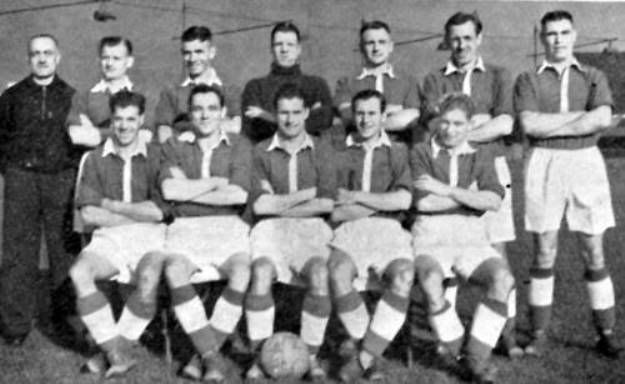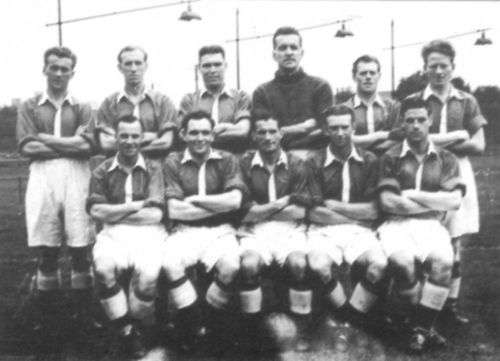SEASON 1950-51
THE POSSIBILITY OF A NEW GROUND
Season 1950-51 was overshadowed by off the field events rather than the playing performances. The big news at the start of the season was the progression of the new Stadium and the purchase of the land, but this should have been bringing the club together actually worked in the opposite direction. The original plan was for an all purpose Sports Stadium for the Borough, but with a change of plan it was decided to build a football only stadium for Roots Hall. Today that might seem as a sensible and logical idea but in 1950, with a great sense of fair-play, some were very upset, the chairman Nevil Newitt resigning over the issue.
Another blow before the season started was the suspension of skipper Jimmy McAlinden for receiving an illegal payment from Portsmouth some years before he even joined Southend. It was a crucial blow as the team was planned around McAlinden and the club appealed against the decision which seemed extremely harsh on Southend United who had done nothing wrong, but of course it was rejected. The loss of McAlinden until October was somewhat offset with the news that former star Joe Sibley was returning to the club from Newcastle for whom he had left for a big fee previously. The club was still maintaining its “buying club not a selling club” stand and this was reinforced with the signing of centre half Jim Stirling, however the club was stunned with the news that Jimmy McAlinden wanted to leave. Thankfully he didn’t go, but that was his choice not the club who had little say in the matter. Then up and coming young inside forward Reg Davies was transferred to Newcastle for a fee of about £10,000, the club admitting that they needed the cash, new grounds aren’t cheap. An injury to Albert Wakefield was another serious blow but Leslie Stubbs was maturing fast and made the transition to leader well. So with all this turmoil the season seemed insignificant. Without the suspension of McAlinden who knows what the Blues could achieve, perhaps higher than last season’s third place. They were third after three games, fifteenth after seven, and by the end of September were fourth. Strangely enough with McAlinden’s return to the side their performances rather fell away and by the end of the year they had settled in eleventh position, and from then on they steadily climbed the table. The climax was match no. 41 of 46 and a 3-2 victory over eventual champions Nottingham Forest with Blues back into fourth position and briefly the possibility of promotion looked like it could happen. Then of course Southend faded and they finished in seventh spot. Two games in the season stand out both against Swindon, the first a huge disappointment losing 0-3 at the Stadium in the F.A.Cup and then three months later the repeat fixture saw Swindon take a two goal lead but the Blues replied with eight goals. Perhaps these two fixtures sum up the season.
F.A.Cup Round 1
Southend United 0-3 Swindon Town.
Any hopes the United had of a run in the F.A. Cup were soon dashed when in their second home Cup-tie in twelve years, after one of the poorest displays by the United for some time thy were defeated by Swindon. It was heart breaking for the 10,000 fans who saw this game in the drizzling rain. Once again the United were unable to finish and on the very heavy pitch persisted in playing the short passing game, instead of opening up the game. Most disappointing feature of the game was the failure of Wakefield and it is now several weeks since he scored. Swindon’s three goals were scored in the second half in the 53rd, 67th and 87th minute and there was never any doubt as to their superiority in front of goal throughout the whole 90 minutes. As the final goal went in and many of the crowd were making their way to the exits, one lone Supporter played the “last post” on his bugle, usually reserved for celebrating goals. Team: Nash; Loughran and Walton; French, Woodward and Lawler; Butler, McAlinden, Wakefield, Grant and Davies
No.32 Div 3 (South)
Southend United 8-2 Swindon Town.
If revenge is sweet then Southend have every reason to be proud and happy with themselves this week, the 10,000 crowd saw United strike their most devastating form of the season, they played as a team and every one of the eleven men gave their best.. For the first fourteen minutes of the game it looked like Swindon were in for a repeat performance, after six minutes they opened the scoring with a long range drive from 30 yards. Swindon went further ahead in the fourteenth minute when they dribbled through the Blues defence and a perfect cross was netted. United supporters were groaning and prepared to face up to a home defeat but in the 18th minute Tippett scored the goal which proved the turning point. McAlinden had gathered the ball in the middle of the field putting a pass through to Sibley who’s accurate centre was sliced into the net by Tippett, and two minutes later the scores were level when Davies intercepted a bad back pass. Three minutes later Southend where in front when again after the McAlinden/Sibley partnership Grant headed home. Five goals in 23 minutes was good value for anybodies money but they were not finished on 32 minutes when Lawler crashed home a shot from a corner. By this time the Blues totally dominated the game and a further goal was added through Grant from a Sibley centre. Tippett came more into the picture and he netted his second in the 61st minute, then Sibley with another of his dazzling runs lead to another goal by Tippett, and Three minutes later the scoring was complete thanks to Tippett again from a Sibley centre Team: Scannell; Loughran and Anderson; French, Stirling and Lawler; Sibley,McAlinden, Grant, Stubbs and Davies.
The leading appearances were: Lawler 45; French 43; Loughran 42; Sibley 39; McAlinden 32; Stubbs 31; Anderson Tippett 30; While 5 Goalscorers reached double figures: Stubbs 19; Wakefield 15; Davies, Grant and Tippett 12 each
THE RESERVES
It had been generally accepted that the Reserves were entertaining to watch, with the chance of seeing clubs and players from higher spheres, but any success certainly wasn’t expected. This theory had partly been dispelled during Season 1949-50 when Southend won their 14 match Combination Cup Group but it was thought that was just a flash in the pan. However in the 1950-51 in the Combination League the young Blues put up a very creditable showing finishing runners up in their 16 team group. They started well with straight wins scoring 11 goals against 2 conceded, but the good start didn’t last and by mid October with 17 games gone they had still only won three more games than they had lost. They then won their next five games scoring 17 conceding 3, which included a 4-0 against Crystal Palace, a 4-0 Bristol Rovers and a 4-2 against Swansea. They found themselves level at the top of the table with Arsenal on points just second on goal average, and their next game was at home to Arsenal. The game was played in front of league size crowd but the game ended in a draw, and in reality that was the end of Southend’s hope of winning the group but they finished second, in a group which had the reserve sides of two First Division, eight Second Division clubs and five Third Division clubs.





